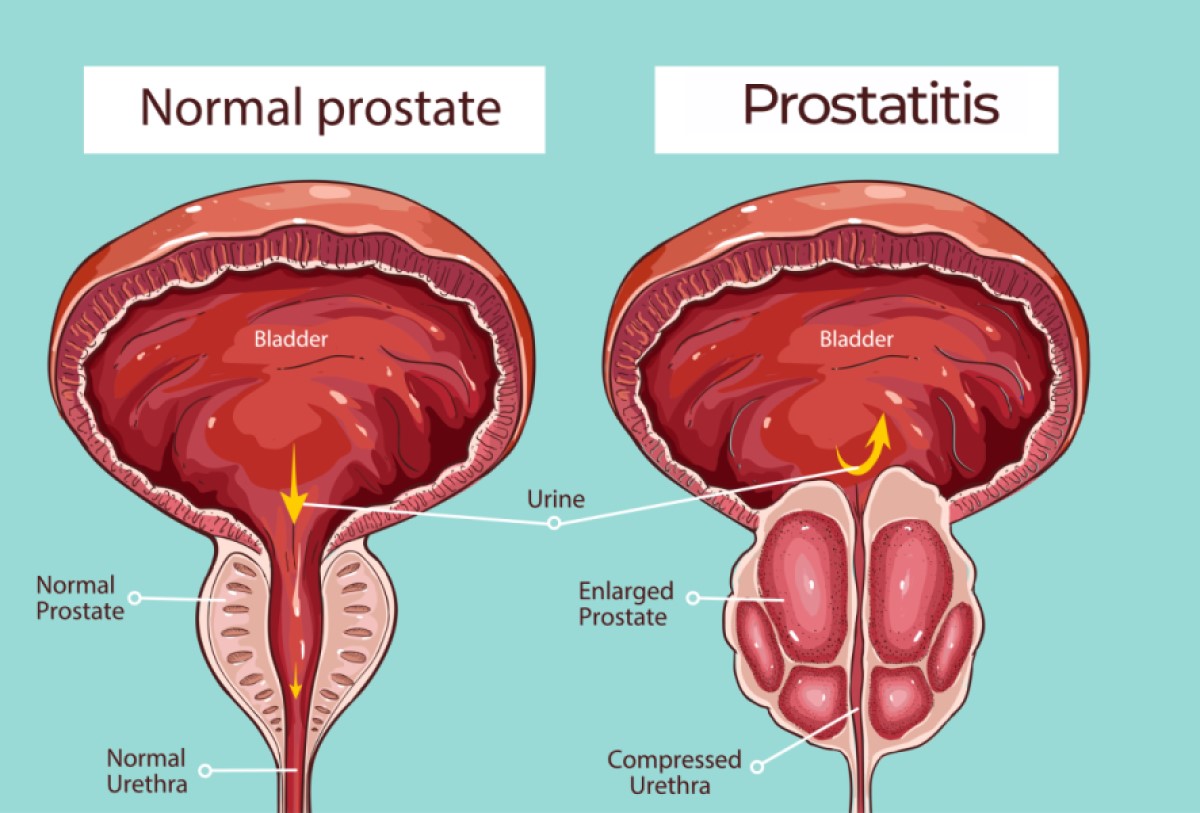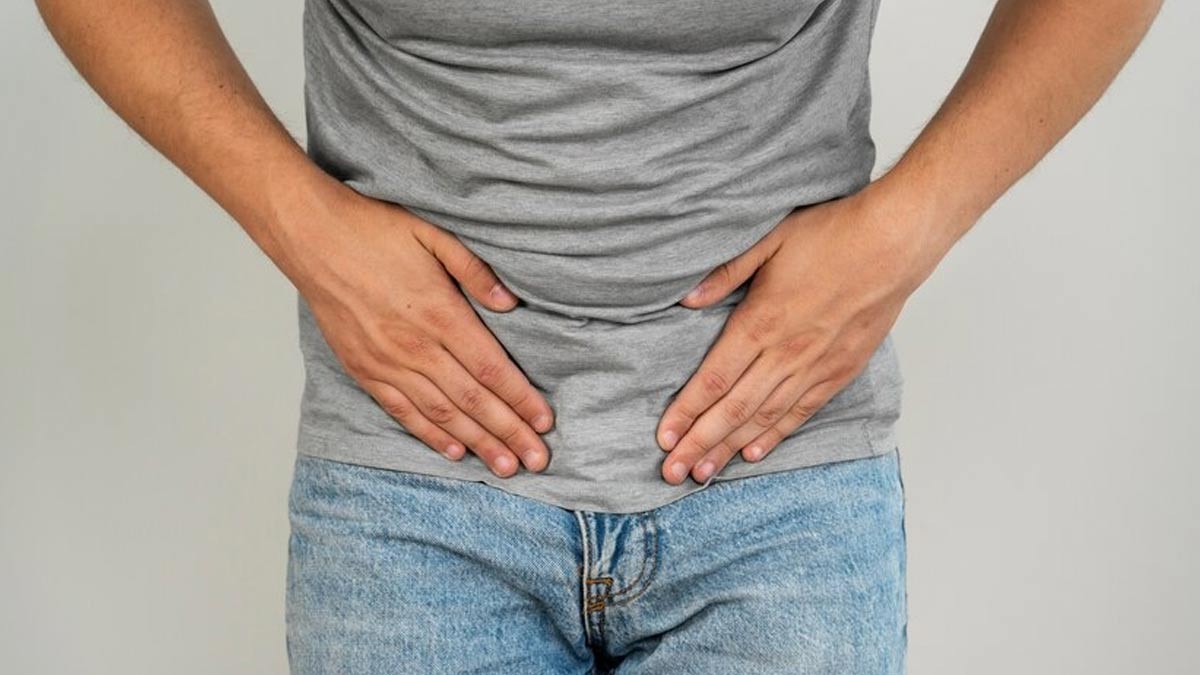
As you age, certain health concerns become more prevalent, and an enlarged prostate is one of them. This condition, also known as benign prostatic hyperplasia (BPH), affects many men over 50 and can have a significant impact on your quality of life. Recognizing the symptoms early on is crucial to manage the condition effectively and prevent complications like urinary tract infections.
You might wonder how to identify if you’re experiencing prostate enlargement. This article will guide you through the common urinary symptoms of BPH, non-urinary signs to watch out for, and risk factors that increase your chances of developing this condition. We’ll also discuss when it’s time to seek medical attention and provide a brief overview of available treatment options. By the end, you’ll be better equipped to recognize and address potential prostate issues.
Common Urinary Symptoms of BPH
Benign prostatic hyperplasia (BPH) is a condition that affects many men as they age. It’s characterized by an enlargement of the prostate gland, which can lead to a variety of urinary symptoms. Recognizing these symptoms is crucial for early detection and management of BPH. Here are some of the most common urinary symptoms you might experience:
Increased Urinary Frequency
One of the hallmark signs of BPH is the need to urinate more often than usual. You might find yourself:
- Making frequent trips to the bathroom, especially during the night
- Needing to urinate seven or more times in a 24-hour period
- Waking up more than twice during the night to use the toilet
This increased frequency occurs because the enlarged prostate puts pressure on your bladder, reducing its capacity to hold urine. As a result, you feel the need to empty your bladder more often, even when it’s not completely full.
Urgency to Urinate
Urinary urgency is another common symptom of BPH. This is characterized by:
- A sudden, strong urge to urinate that can be difficult to control
- Feeling like you need to rush to the bathroom immediately
- Potential leakage of urine before reaching the toilet
This urgency is caused by the enlarged prostate pressing against the urethra, which increases bladder sensitivity. The sensation can come on suddenly and may be hard to control, potentially disrupting your daily activities and sleep patterns.
Weak Urine Stream
As BPH progresses, you might notice changes in your urine flow. These can include:
- A weak or hesitant urine stream
- Difficulty starting urination
- Taking longer than usual to empty your bladder
- A stream that starts and stops
These symptoms occur because the enlarged prostate narrows the urethra, making it harder for urine to flow freely. You might find yourself straining to start urination or feeling like your bladder isn’t completely empty after you’ve finished.
In addition to these primary symptoms, you might also experience:
- Dribbling at the end of urination
- The sensation of incomplete bladder emptying
- Pain or discomfort while urinating
- Occasional blood in the urine
It’s important to note that while these symptoms are common in BPH, they can also be caused by other conditions such as urinary tract infections, bladder stones, or in rare cases, prostate cancer. Therefore, if you’re experiencing any of these symptoms, it’s crucial to consult with a healthcare professional for a proper diagnosis.
Remember, less than half of all men with BPH experience noticeable symptoms. However, if you do have BPH, it’s recommended to have a yearly assessment to monitor your symptoms and determine if any changes in treatment are necessary.
Non-Urinary Signs of Prostate Enlargement
While urinary symptoms are the most common signs of an enlarged prostate, you may also experience non-urinary symptoms that can impact your overall well-being. These symptoms can affect your daily life and sexual health, making it important to recognize them early.
Discomfort in the Pelvic Area

As your prostate enlarges, you might notice discomfort or pain in various areas of your pelvis. This can include:
- Pain in your lower abdomen
- Discomfort in your genitals or perineum (the area between your scrotum and rectum)
- Pain that may spread to your lower back
These sensations can range from mild to severe and may come and go. In some cases, the pain can last for months or even years, especially if you’re experiencing chronic pelvic pain syndrome (CPPS), which affects approximately 1 out of 3 people assigned male at birth.
It’s important to note that pelvic pain doesn’t always stem entirely from the prostate itself. Other factors that might contribute to chronic pelvic pain include:
- Autoimmune diseases
- Pelvic floor muscle damage
- Pelvic nerve irritation or inflammation
- Stress
If you’re experiencing persistent pelvic discomfort, it’s crucial to consult with a healthcare professional for a proper diagnosis and treatment plan.
Sexual Function Changes
An enlarged prostate can have a significant impact on your sexual health and function. You may notice several changes, including:
- Erectile Dysfunction (ED): As your prostate enlargement progresses, you might have difficulty achieving or maintaining an erection. The severity of your lower urinary tract symptoms (LUTS) can be directly related to the likelihood of experiencing ED.
- Reduced Libido: You may find that your interest in sexual intercourse declines as your symptoms become more severe.
- Ejaculation Issues: An enlarged prostate can lead to:
- Painful ejaculation
- Reduced ejaculate volume
- Difficulty ejaculating
- Overall Sexual Satisfaction: Men with more severe lower urinary tract symptoms (LUTS) often report lower levels of sexual satisfaction compared to those with milder symptoms.
It’s important to understand that these sexual changes can have an emotional impact and affect your quality of life. The distress caused by sexual disorders is strongly related to both age and the severity of your prostate symptoms.
When seeking treatment for an enlarged prostate, it’s crucial to discuss any sexual function changes with your healthcare provider. Some treatments for benign prostatic hyperplasia (BPH) may have sexual side effects, while others might actually improve sexual function. For example, certain medications used to treat ED may also help alleviate BPH symptoms when taken daily.
Remember, the relationship between prostate enlargement and sexual function is complex. By addressing both issues simultaneously, you and your healthcare provider can work together to find a treatment plan that improves your overall quality of life.
Risk Factors for Developing BPH
Understanding the risk factors for benign prostatic hyperplasia (BPH) can help you recognize your likelihood of developing this condition. While some factors are beyond your control, others can be influenced by your lifestyle choices.
Age
As you grow older, your chances of developing BPH increase significantly. This condition is often considered a normal part of aging in men. Here’s how age affects BPH prevalence:
- 8% of men aged 31 to 40 have BPH
- 50% of men in their 60s have BPH
- Over 80% of men above 80 years old have BPH
The prostate naturally enlarges to some degree in all men as they age. However, it’s important to note that not all men with an enlarged prostate require treatment. The prevalence of BPH rises markedly after the age of 40, with studies showing a histological prevalence of:
- 8% in the 4th decade of life
- 50% in the 6th decade of life
- 80% in the 9th decade of life
Your prostate volume also increases with age, with a growth rate of 2.0%-2.5% per year in older men. This continued growth is a risk factor for lower urinary tract symptoms (LUTS) progression and increases the risk of urinary retention and need for prostate surgery.
Family History
Your genetic makeup plays a significant role in determining your risk of developing BPH. Evidence suggests a strong genetic component to this condition. If you have male relatives who have experienced BPH, you may be at a higher risk. Studies have shown:
- Male relatives have a 4-fold increase in age-specific risks for BPH surgery
- Brothers have a 6-fold increase in age-specific risks for BPH surgery
- Approximately 50% of men below 60 years undergoing surgery for BPH have a heritable form of the disease
Interestingly, heritable BPH is associated with larger prostate volume and younger age of onset compared to sporadic BPH.
Lifestyle Factors
Your daily habits and choices can significantly impact your risk of developing BPH. Here are some lifestyle factors to consider:
- Diet: Your eating habits can influence your BPH risk. Increased intake of total energy, protein, red meat, fat, dairy products, cereals, bread, poultry, and starch may potentially increase your risk of clinical BPH and BPH surgery. On the other hand, a diet rich in vegetables, fruits, polyunsaturated fatty acids, linoleic acid, and vitamin D may potentially decrease your risk.
- Physical Activity: Regular exercise has been consistently linked to decreased risks of BPH surgery, clinical BPH, histological BPH, and LUTS. A meta-analysis of 11 studies involving 43,083 participants showed that moderate-to-vigorous physical activity could reduce the risk of BPH by as much as 25% compared to a sedentary lifestyle.
- Alcohol Consumption: Moderate alcohol intake appears to have a protective effect against BPH. A meta-analysis of 19 studies with 120,091 participants observed up to a 35% decreased likelihood of BPH among men who drank daily.
- Sleep Habits: Recent studies have shown a strong causal relationship between sleep levels and BPH. Adequate sleep duration appears to be a protective factor against BPH. Getting enough sleep can reduce your risk of prostate enlargement, especially if you’re older and experiencing symptoms.
- Obesity and Metabolic Syndrome: Some evidence suggests that being obese or having metabolic syndrome (a group of risk factors including abdominal obesity, high blood pressure, insulin resistance, and low HDL cholesterol levels) may increase your risk of developing BPH.
When to Seek Medical Attention

While an enlarged prostate is a common condition, it’s crucial to know when to seek medical attention. Recognizing the signs that require immediate care can help prevent serious complications and ensure timely treatment.
Severe Symptoms
You should contact your healthcare provider if you experience any of the following severe symptoms:
- Difficulty urinating or complete inability to urinate
- Pain or burning sensation while urinating
- Lower abdominal or genital pain during urination
- Blood in your urine (hematuria)
- Fever or chills accompanied by painful, frequent, or urgent urination
It’s important to note that even if your symptoms don’t bother you significantly, you should still discuss them with your healthcare provider. Early detection and treatment can prevent more serious issues from developing.
If you’re unable to urinate at all, this is considered a medical emergency. Seek immediate medical attention at the nearest emergency room. This condition, known as urinary retention, may require the insertion of a catheter to drain your bladder.
Complications
Untreated benign prostatic hyperplasia (BPH) can lead to various complications that require medical intervention. Be aware of the following potential issues:
- Urinary Tract Infections (UTIs): If you’re experiencing frequent UTIs, it might be a sign that you’re unable to empty your bladder completely. This may require surgical intervention to remove part of the prostate.
- Bladder Stones: These can cause illness, bladder irritation, blood in the urine, and blocked urine flow. If you suspect bladder stones, consult your healthcare provider promptly.
- Bladder Damage: Over time, an incompletely emptied bladder can stretch and weaken, making it harder to fully empty. This can lead to chronic urinary retention.
- Kidney Damage: Increased pressure in the bladder due to urinary retention can potentially damage your kidneys or allow bladder infections to spread to the kidneys.
- Chronic Urinary Problems: If you’ve had BPH for a long time with gradually worsening symptoms, you may develop sudden urinary retention or recurrent urinary tract infections.
It’s crucial to seek medical attention if you’ve tried self-care steps for two months without improvement in your symptoms. Additionally, if you’re taking medications that may cause urinary problems (such as diuretics, antihistamines, antidepressants, or sedatives), consult your healthcare provider before making any changes to your medication regimen.
Remember, about one-quarter of men with BPH in the United States will experience urinary problems that require treatment. Don’t hesitate to seek medical attention if you’re concerned about your symptoms or their progression.
Conclusion
Recognizing the symptoms of an enlarged prostate is crucial to maintain a good quality of life as you age. This article has provided a comprehensive overview of the common urinary and non-urinary signs to watch out for, as well as the risk factors that increase your chances of developing benign prostatic hyperplasia. By understanding these aspects, you’re better equipped to identify potential issues early on and seek timely medical attention.
Remember, while an enlarged prostate is a common condition in older men, it doesn’t have to control your life. If you notice any concerning symptoms or changes in your urinary habits, don’t hesitate to talk to your doctor. Early detection and proper management can help prevent complications and keep you feeling your best. Stay proactive about your health, and don’t let prostate issues hold you back from enjoying life to the fullest.
** Our website contains affiliate links. This means if you click and make a purchase, we may receive a small commission. Don’t worry, there’s no extra cost to you. It’s a simple way you can support our mission to bring you quality content.
FAQ
1. How can someone recognize if they have an enlarged prostate?
Benign prostatic hyperplasia (BPH) is a condition where the prostate gland enlarges, primarily affecting men and individuals assigned male at birth as they age. Key symptoms include experiencing difficulty in urinating and a sudden, urgent need to urinate.
2. What methods are available to check for an enlarged prostate?
To accurately assess for an enlarged prostate, an at-home PSA blood test is available, but it is limited in scope. For a comprehensive evaluation, it is advisable to consult a physician who can perform a digital rectal exam. This exam allows the doctor to physically check the prostate for any irregularities such as lumps or enlargement.
3. What other conditions can appear similar to an enlarged prostate?
Several conditions can present symptoms similar to those of benign prostatic hyperplasia (BPH), including urethral stricture, bladder cancer, bladder stones, and abnormalities in bladder or pelvic floor function. These could stem from neurogenic disorders affecting bladder control or spasms in the pelvic floor muscles. A detailed medical history can help in distinguishing these conditions.
4. What are the noticeable symptoms of an enlarged prostate?
The symptoms indicative of an enlarged prostate include difficulty initiating urination, a weakened urine flow, intermittent stopping and starting of urine flow, the need to strain while urinating, and frequent urination urges. These symptoms can significantly affect daily life and warrant medical consultation.

This article does a great job of breaking down the symptoms and risk factors of an enlarged prostate in a clear, understandable way. I appreciate how it emphasizes early detection and proactive management, which are key in preventing complications. The section on non-urinary signs was particularly insightful, as many people might not realize that discomfort in the pelvic area or changes in sexual function could be related to BPH.
I also liked how it touched on lifestyle factors like diet, exercise, and even sleep habits things that are often overlooked but can make a big difference. Overall, it’s a thorough and informative read that encourages men to stay on top of their health as they age.
Hi Kavitha,
Thank you so much for your thoughtful comment! I’m glad you found the article helpful and that the emphasis on early detection and proactive management resonated with you. It’s true—many people don’t realize that symptoms beyond urinary issues, like pelvic discomfort or changes in sexual function, can be connected to BPH.
Lifestyle factors like diet, exercise, and sleep are also important aspects that can make a big difference in managing symptoms.
I appreciate your feedback and am happy you found the information useful in promoting men’s health!
Very informative article on the symptoms of an enlarged prostate! It’s a topic that’s often overlooked, but so important for senior men to understand. I’m curious about how lifestyle changes, like diet or exercise, can help manage symptoms before medical intervention is necessary. Are there any specific habits that have shown significant benefits in reducing discomfort or slowing the progression of symptoms? I’d love to hear more about natural approaches to managing this condition.
Thank you for your insightful comment! You’re absolutely right—understanding the symptoms of an enlarged prostate is crucial for senior men. Lifestyle changes can play a significant role in managing symptoms.
Incorporating a diet rich in fruits, vegetables, and healthy fats can be beneficial. Foods high in zinc, like pumpkin seeds, and those rich in omega-3 fatty acids, like salmon, may help support prostate health.
Regular exercise is also important; activities like walking, swimming, or yoga can improve circulation and reduce discomfort. Maintaining a healthy weight can alleviate some pressure on the prostate as well.
Practicing good hydration habits—drinking plenty of water during the day and limiting fluids before bedtime—can also help manage symptoms. It’s great to see interest in natural approaches, and making these adjustments can truly make a difference!
John, this is such an informative and well-organized article! I appreciate how you’ve broken down the symptoms, risk factors, and even lifestyle influences in a way that’s easy to understand. The section on non-urinary symptoms, like pelvic discomfort and sexual health changes, really sheds light on aspects of an enlarged prostate that often go unnoticed or unmentioned.
I’m curious, though, do you think awareness campaigns around prostate health focus enough on these less-discussed symptoms?
It seems like they could play a huge role in encouraging earlier medical consultations and better outcomes for men dealing with BPH.
Hi Ben,
Thank you so much for your kind words and thoughtful feedback! I’m glad the article resonated with you, especially the section on non-urinary symptoms like pelvic discomfort and changes in sexual health. These are indeed important aspects of BPH that often get overshadowed by the more well-known urinary symptoms.
You raise an excellent point about awareness campaigns. While many initiatives focus on urinary symptoms, there is definitely room to emphasize the broader spectrum of effects that an enlarged prostate can have on men’s overall health and quality of life. Highlighting less-discussed symptoms like pelvic pain or sexual health changes could be instrumental in encouraging earlier medical consultations.
Awareness efforts that incorporate these aspects could also help break down stigmas, making it easier for men to talk about their concerns and seek help. Prostate health campaigns could benefit from a more holistic approach—addressing not just the physical symptoms but also the emotional and relational impacts of BPH.
Thank you for bringing this up! It’s a valuable perspective, and I’ll certainly take it into consideration when updating future content or sharing related topics. If you have any other thoughts or suggestions, I’d love to hear them! 😊
Cheers
John
Hi John,
This insightful article is a must read for all, especially men!
The highlight and explanation of the common urinary and non-urinary signs to watch out for and the risk factors in benign prostatic hyperplasia are so insightful, helpful, and cardinal factors in managing BPH and maintaining an active and healthy quality of life while ageing, in my opinion.
The mention of age, family history, diet, and lifestyle, especially as it is the norm in the modern world of the internet and an inactive lifestyle, is particularly commendable.
I’m just wondering: could other health management methods, e.g., alternative medicines, be included in the prevention and treatment regime of BPH in addition to the helpful methods suggested in your informative article?
Thank you for these valuable pieces of information; they are very helpful and enriching.
I’m sure going to share this with friends and family male members.
– Makinde
Hi Makinde,
Thank you so much for your thoughtful comment and for appreciating the article—it truly means a lot! I’m glad you found the discussion on urinary and non-urinary symptoms, risk factors, and lifestyle influences helpful. It’s great to see you highlighting the importance of staying proactive about health, especially as we age.
You bring up an excellent point about alternative medicine and its potential role in preventing and managing BPH. Many men have found value in incorporating complementary approaches alongside conventional methods. Here are a few examples of alternative treatments that might be helpful:
1. Herbal Remedies:
– Saw Palmetto: This is one of the most widely researched natural supplements for BPH. It may help reduce urinary symptoms by inhibiting certain hormones that contribute to prostate enlargement.
– Pygeum (African Plum Extract): Studies suggest it may improve urinary flow and reduce nighttime urination.
– **Stinging Nettle Root:** Often used in Europe for BPH, it may help alleviate urinary symptoms when combined with other treatments.
2. Dietary Adjustments:
– Anti-inflammatory foods, like those rich in omega-3 fatty acids (e.g., fatty fish, walnuts) and antioxidants (e.g., berries, green tea), can promote prostate health.
– Limiting red meat and processed foods while increasing plant-based meals can also be beneficial.
3. Lifestyle and Stress Management:
– Practices like yoga, tai chi, or meditation can help reduce stress, which might otherwise exacerbate BPH symptoms.
4. Acupuncture:
– Some men find relief from urinary symptoms through acupuncture, as it may improve blood flow and balance energy levels in the body.
I’ll certainly consider expanding the article to include these alternative approaches, as they can offer additional options for managing BPH. Thank you again for sharing your thoughts and for spreading the word—it’s wonderful to know this information will reach more people who could benefit from it! Let me know if you’d like further details about any of these methods. 😊
Cheers
John